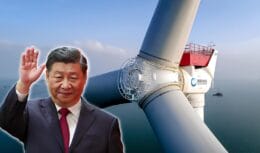
Rio Grande do Sul is the Brazilian state with the largest number of registered projects aimed at building parks for the production of offshore wind energy
According to information released by GZH Economy, Rio Grande do Sul currently stands out as the Brazilian state with the highest concentration of companies interested in installing offshore wind farms in the country. There, 17 of the 54 enterprises are present, in all, aimed at this source of clean energy and registered with the Brazilian Institute of the Environment and Renewable Natural Resources (Ibama).
However, to materialize this potential, further expansion of the electrical transmission capacity in the state and the adjustment of legal norms are still necessary.
The search for more sustainable energy sources, replacing fossil fuels, has as one of its most promising alternatives the exploitation of winds over the sea or lakes to generate energy. wind power. Although the cost of setting up offshore parks is quite high, many companies decide to prioritize it due to the existence of stronger and more constant winds, in addition to less competition for space.
In Brazil, there is still no enterprise of this type, but the state of Rio Grande do Sul has great advantages for the generation of offshore wind energy. The state of Rio Grande do Sul, for example, has strong winds over the sea, which would make it possible to produce up to 80 gigawatts of energy – a value four times greater than all the currently installed capacity in onshore wind farms in the country.
In addition, the interest of the private sector in the state can also be explained by other factors, such as the structure and spaces available in the port of Rio Grande, the qualification of professionals and the excellent quality of universities.
As evaluated by the executive president of the Brazilian Association of Wind Energy (Abeeólica), Elbia Gannoum, offshore projects involve, in addition to the intensity of the winds, the need for port infrastructure and transmission capacity. For her, Rio Grande do Sul has been a great attraction thanks to its already good infrastructure.
Projects registered with Ibama add up to 15,5 gigawatts on land and 44,7 gigawatts of energy at sea. In this sense, new investments are needed for the costing and construction of new lines.
Under this bias, Marjorie Kauffmann, state secretary for the Environment and Infrastructure, says that the state has organized itself, along with the National Electric Energy Agency and the Ministry of Mines and Energy, to discuss the expansion of the grid. According to her, there is enough time, until the projects are implemented, to increase her network.
It is important to highlight that, although it is seen as a clean and renewable source of energy, the exploration of offshore wind farms is also a matter of concern for environmentalists. Thus, entities such as the Rio Grande do Sul Association for the Protection of the Natural Environment (Agapan) have already requested the elaboration of clear rules and the active and transparent inspection of these plants, such as the creation of fines and action plans for eventual environmental disasters.
First offshore wind power plants to be installed by 2030
According to forecasts by specialists and public managers, the first offshore wind farms should start transforming wind into energy in the Rio Grande do Sul in mid-2030. Therefore, if expectations are confirmed, the state may suffer a significant economic leap in the following years.
The time interval is necessary for the country to complete adjustments to the legal norms, providing legal certainty to the licensing process for offshore projects. In this way, interested companies must carry out environmental studies to obtain preliminary licenses for installation and operation, and for the assembly of wind turbine parks on water.
In the case of offshore wind farms, the licensing process takes place at the federal level, and for complexes in inland waters, such as lagoons, it takes place at the state level. Rio Grande do Sul already has, for example, businessmen interested in installing power plants in Lagoa dos Patos.
It is difficult to accurately predict all the investment to be made in the state. This is because, in addition to having to go through all the stages of environmental licensing, at least four projects overlap with other existing projects, making it impossible to make all of them feasible. However, one of the most advanced projects, by Ocean Winds, which will be responsible for the implementation of two complexes, intends to invest up to R$ 120 billion alone.
Therefore, if the investors' interest is confirmed, Rio Grande do Sul will receive an amount of private resources as never seen before. For comparison purposes, one of the largest investments recently discussed in the state, for the regasification complex in Rio Grande, was valued at “only” R$ 6 billion.
The chief secretary of the Civil House, Arthur Lemos, declares that, taking place gradually, these investments have the capacity to keep the state's economy warm for a long time. Furthermore, Lemos explains that there would be a positive impact on the entire associated production chain, with results obtained in the manufacturing industry and technology centers.
Port of Rio Grande has already attracted the attention of eight investors in the offshore wind sector
Ports are extremely important installations for carrying out wind energy exploration projects on the high seas, as they allow the arrival, handling and dispatch of large parts. Given this context, the port of Rio Grande, in the south of the state of Rio Grande do Sul, is already attracting the attention of potential investors in this sector.
Fernando Estima – Planning manager at Portos RS – explained that eight business groups have already shown formal interest in transforming the port in Rio Grande do Sul into a possible base of operations for wind projects offshore.
The manager pointed out that a service routine has even been organized to receive representatives of these companies. According to him, the port is deep enough to accommodate large ships, in addition to two shipyards available, plenty of space and skilled labor. Estima also recalled that two or more companies can share shipyards.
Arthur Lemos explains that, with this, the intention of the government of Rio Grande do Sul is to take advantage of the stimulus caused by sea winds to boost other sectors of the state economy, so that the largest possible part of the materials used in the wind complexes is built in the state itself.
Finally, Lemos argues that the idea is to take advantage of the qualities of Rio Grande do Sul, such as the production chain and universities, so that new investments are a vector of development.












